
|
|

|
|
In This Issue:
RCD Gives Away Sand for Gardening, Recreation
The Give Away lasted all day on Saturday October 10, and from the moment the gate opened at 9:00 a.m., people began arriving to claim free sand. Over 140 cubic yards of sand was given away (the equivalent of 140 small pick-up loads) to over 25 people, some of whom returned again and again for the free sand. The sand will be put to many uses, from creating a "paved" parking area, to enriching clay soils in home gardens, to lining running tracks and other recreation spots. The sand comes from the "Hamilton Ponds," which capture sediment at the mouth of Grass Valley Creek to prevent it from entering the Trinity River just below Trinity Dam. Before the Ponds were constructed, the decomposed granite sand flowing out of the highly erosive Grass Valley Creek watershed poured directly into the Trinity River, seriously disrupting salmon and steelhead spawning and rearing habitat. The fine sand once coated the river bed, filling in the pore spaces of the gravel and cobbles salmon and steelhead need for laying their eggs.
1995 and 1997 were very wet years, with large storms causing the delivery of huge amounts of sediment to the ponds. What once looked like placid forest pools began to look more like beaches as the sediment filled up the ponds. Because so much sand had built up, the RCD began, in 1997, to look for ways to put it to practical use. Several projects resulted. One of these was the restoration of the sand beach at Clark Springs, on Trinity Lake. In 1997 the RCD, in cooperation with the US Forest Service and the Trinity Resource Conservation and Development Council, trucked large amounts of the sand to Clark Springs, creating a lovely white sand beach where once bare dirt and star thistle abounded. The summer of 1998 saw the return of sunbathers and swimmers to Clark Springs, and the site now appears to be a very popular recreation area.
Another idea was to create the DG Sand Give-Away Day so that people who might have uses for the sand could simply show up and take as much of it as they desired. All three projects have created successful ways to utilize the sand, which might otherwise simply pile up at the Hamilton Ponds. Since the Ponds have to be dredged of sand every several years it is likely that the RCD will continue to look for ways to utilize it. Efforts to minimize erosion in the Grass Valley Creek watershed are still under-way. It is hoped that the long-term benefits of revegetating the watershed with native trees and plants will result in reduced erosion and therefore reduced sediment delivery to the Hamilton Ponds in the long run. But as long as DG sand from this highly erosive watershed continues to accumulate in the Hamilton Ponds, there will be more sand for recreational uses and home gardening. Keep an eye out for another "DG Sand Give-Away" in the Future!
Recent ProjectsRCD Busy With Many Projects This FallThe RCD is keeping active this fall implementing a number of projects around the county. Focus areas include ongoing work in Grass Valley Creek, the South Fork of the Trinity River, and two communities in northern Trinity County.
Dredging the Grass Valley Creek Sediment PondsThis fall the large sediment catchment ponds, known as the "Hamilton Ponds," at the mouth of Grass Valley Creek (GVC) were dredged of 42,000 cubic yards of decomposed granite sediment. Sediment accumulates in the ponds, particularly after large storms, because the soils in the GVC watershed are highly erodible.The Hamilton Ponds were constructed in 1988 in an effort to keep sediment from the watershed from entering the Trinity River just below Lewiston. The GVC watershed was identified in a study conducted during the 1970's as the single largest source of sediment to affect the fisheries of the Trinity River. The ponds are effective at keeping sediment flowing down GVC from entering the Trinity River, but the sediment needs to be periodically removed from the ponds for them to remain effective. The Ponds were last dredged in 1997. The relatively frequent rate of dredging in the past few years has been due to the large winter storms the county has experienced, especially those of 1995 and 1997. Storms such as these cause extensive erosion in the watershed, which has historically been highly erosive, but this problem has been heightened by the amount of logging roads constructed in the watershed between the 1950's and 1980's. Many of these roads were constructed before the adverse affects sediment has on streams were properly understood. The RCD began eliminating or upgrading these roads in the early 1990's in order to minimize the potential for future sediment impact to GVC itself. Although there is evidence such restoration work has been effective in controlling sediment delivery from roads, large storms still have a significant impact on slopes and stream channels themselves. The RCD continues to try to reduce the level of erosion in the watershed by revegetating logged areas in the hope that soils will stabilize over time. Revegetation and road removal are a long-term solution. Short-term impacts still occur, especially during large storms, and that is why the Hamilton Ponds are so important: almost none of this sediment reaches the Trinity River because the Ponds catch and hold sediment, where it can be removed as necessary.
Road Improvement Projects in the South Fork
Projects include upgrading culverts (to allow them to accommodate higher flows during severe storms), installing flared ends and bevel cuts to culvert inlets, creating "critical dips" at stream crossings, and rolling dips to improve road drainage. The crew is also creating "rocked crossings," or fords to replace culverts where such fords are possible. The most difficult aspect of these projects is their remoteness. Project implementor Cynthia Tarwater said she is tired of driving to reach project sites, which may require up to 2 hours on the road just to reach a site. The projects are part of an ongoing agreement the RCD has with the US Forest Service to "storm proof" these watersheds, which are important cool water refugia for spring-run Chinook salmon. Many areas of the watersheds were identified as having potential to deliver significant amounts of sediment, which is harmful to fish habitat, during large storms. This is part of the RCD's and the South Fork Coordinated Resource Management Planning group's aim to protect the anadromous (salmon and steelhead) fisheries of the South Fork of the Trinity River.
Road Inventory in the South ForkThe RCD has begun work in another part of the South Fork watershed, the Upper South Fork headwaters area on the west side of the river and Plummer Creek watershed on the east side.The RCD is inventorying the road network in these watersheds in order to determine if any portions of the roads need work to better prepare them for large, potentially devastating storms, the so-called "100-year events" (see also the related article on page 7 of this issue).
Community Fuels Reduction EffortsTwo projects intended to address the accumulation of wildland fuels in the county are underway, one in the East Branch of Weaver Creek and the other in Covington Mill. The projects are funded by the California Department of Forestry and Fire Protection's California Forest Stewardship Program.The East Branch project, begun in 1996, is a demonstration project for the treatment of fuel buildup. The project has brought together area residents and fire and forestry experts. The East Branch community has thinned forested areas and removed fuel ladders to create defensible spaces around homes. The next phase of the project will upgrade road access and reduce erosion potential along the upper portion of East Branch Road, create a fuelbreak along the ridges on Forest Service lands, implement prescribed burns, continue fuel reduction activities at homesites and along the primary access road, and develop a brochure with highlights of the Plan for distribution. The Covington Mill project will unfold similarly to the East Branch project, including thinning, removing fuel ladders, and creating road buffers. This project will also fund the development of a Forest/Fire Management Plan for Covington Mill and the surrounding area. These projects are part of a larger effort to address the problem of fuels accumulation in the county. A Fire Safe Council has been initiated to develop a proactive approach to deal with the threat of catastrophic fire on public and private lands throughout Trinity County. The Fire Safe Council is made up of representatives from local, state, and federal agencies, watershed-based groups, industry and commercial associations, the Volunteer Fire Chiefs Association, neighborhood associations, and private landowners.
Employee FeaturePolly Taylor
The crew gathers data on roads such as length of the road, number and type of crossings, and any other anomalies, such as landslides and washouts. The data will be used to determine the locations and nature of any modifications to the road network, such as replacing culverts with rocked crossings or upgrading them to withstand higher flows by increasing culvert diameter. Polly has worked on the Trinity River Restoration Project for various agencies since 1992, including the California Department of Fish and Game, the US Fish and Wildlife Service, and the US Forest Service. She started as a volunteer technician and eventually learned the skills of her trade, which include monitoring fish counts in the South Fork: adult spawning, juvenile, and redd counts. Polly's family history reaches way back into the annals of Trinity County history: her great grandfather was one of the original "forty niners" during the gold rush days and he established a claim in 1854 near Junction City, a claim that the family still holds. Her mother's side of the family is descended from Wintu Indians, who have inhabited Trinity County since prehistoric times. Polly was raised in Trinity County and went to the same schools as her father: Junction City Elementary and Trinity High Schools. Her son Max is now a sixth grader at Junction City, where he has gone to school since kindergarten. After first graduating from high school she spent some time in other places: the Bay Area; Sparks, Nevada; and Sacramento. Like many who grow up in Trinity County who seek out the wide world, she eventually returned home to stay. When she's not driving the remote back roads of Trinity County for the RCD she likes to hike and coach sports, including baseball and basketball. She also likes to read and make quilts, although lately she's been too busy driving to have much time for much else. Not only does her work day include driving miles of road in remote watersheds, but she often commutes between Weaverville and the southern part of Trinity County, a two or three hour drive one way. Polly and the crew do however frequently camp out near the work area to minimize driving, and they have had a chance to have shared many interesting experiences. The most humorous incident was the time she and the crew got a truck she had borrowed stuck off-road on a steep hill. She called her boss on the short-wave radio to tell him what had happened. He said, "Well, can't you pull it out with my truck?" She hesitated before answering: "It's your truck that's stuck," and then cringed while she awaited his response. Eventually they did get the truck out, but it took some doing. Fortunately, day to day work goes a lot smoother than on that embarrassing occasion.
Return to the Trinity County RCD Home Page
|
||||||||||||||||||||||||||


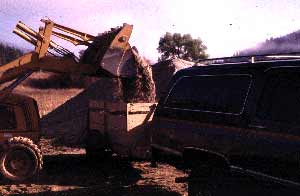
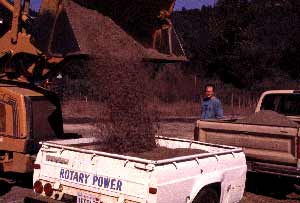
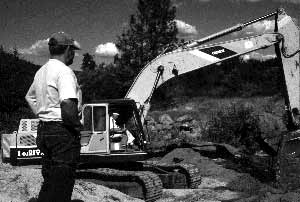
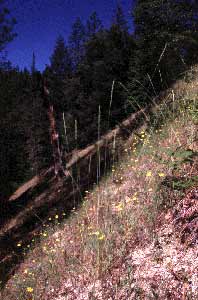
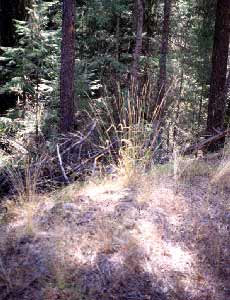
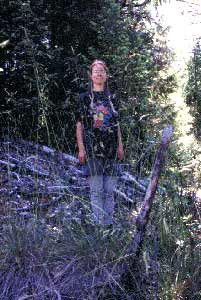
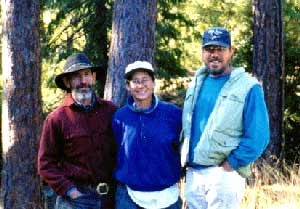

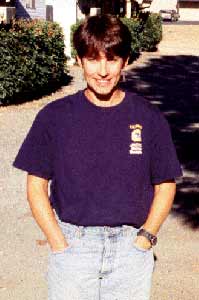 Polly Taylor is the RCD's Road Engineer Technician; she is responsible for supervising a crew inventorying roads in remote areas of the South Fork Trinity River, particularly Forest Service land in Plummer Creek and the Upper South Fork watersheds. The crew is gathering data on the road network in order to determine which roads and parts of roads need to be repaired or improved to withstand large storms, such as those the county saw in 1995 and 1997.
Polly Taylor is the RCD's Road Engineer Technician; she is responsible for supervising a crew inventorying roads in remote areas of the South Fork Trinity River, particularly Forest Service land in Plummer Creek and the Upper South Fork watersheds. The crew is gathering data on the road network in order to determine which roads and parts of roads need to be repaired or improved to withstand large storms, such as those the county saw in 1995 and 1997.